Local artist helps teens in Rwanda, Israel express themselves through art
Published October 10, 2012
Having grown up surrounded by her grandmother’s Jewish art, it is no surprise that Tanya Fredman became an artist whose earliest roots influence her work. Fredman grew up in St. Louis but now lives in Israel, and spent time in Africa working with orphaned children.
In Rwanda, she volunteered with the Agahozo-Shalom Youth Village (ASYV), a residential community in Rwanda for youth orphaned during and after the genocide of 1994. According to its website, the ASYV strives to teach “the principle of serving the community, both locally and globally.” Not only did Fredman organize the painting of an 80-foot mural, a large mosaic bench and plaque in school, but she also led an open studio class for students to work on individual artwork.
“I love Rwanda, and the kids were something special,” Fredman said. “It was amazing to see them grab at the chances to learn.”
Benna Wise volunteered with Fredman at the ASYV. Like other volunteers, Wise was saddened by Fredman’s departure.
“I wasn’t sure how I would feel when [Tanya] left- – whether it would hit me, or whether I would be in a constant state of thinking she’s about to walk through our sliding door,” Wise wrote on her blog. “And I do feel a hole now; I feel an empty room adjacent to mine, an empty seat on our couch, an empty cup of tea, and the first sign of the reality that this isn’t forever.”
ASYV is modeled after Yemin Orde Youth Village (YOYV) in Israel, where Fredman also served as a volunteer. Home to students from over 20 different cultures, YOYV helps reshape the lives of the 125 impoverished orphans and immigrant children who are accepted into the village each year. Fredman, 28, has been involved since the first year of the program, and even played a role in creating the new curriculum. Exposure to the intersection of cultures at YOYV has in turn influenced Fredman’s artwork.
“In my artwork, it’s a lot about meeting points between different cultures,” Fredman said. “As my artwork became a meeting place for cultures, it became a meeting place of fabric.”
After years of volunteer work, Fredman chose to visit her native St. Louis to display her art last year at the same Jewish Community Center (JCC) where Fredman’s grandmother once displayed her own work. Fredman also hoped to emphasize her Jewish roots, which play an important role in her career as an artist.
“I wanted to show [my art] in a Jewish setting, since there is a strong Jewish connection in a lot of my work,” Fredman said.
Fredman’s art display included pieces from her Rwandan collection. The pieces included subtle references to Jewish holidays in a testament to the importance of Judaism in Fredman’s life.
“I was given a choice prior to seeing Tanya’s art as to whether or not to work on the project,” JCC Program Associate Diane Maier, who helped coordinate the event, said. “Once I saw the art, there was no turning back. It’s amazing and beautiful, like Tanya.”
Ever since childhood, Fredman adored art. In fact, Fredman, who is in her late twenties, describes her passion for art as “natural” and instinctive.
“My love for art started with my grandmother,” Fredman said. “I started painting and drawing and loved it. It just seemed natural.”
Fredman studied art at Brandeis University. After travelling from Israel to Africa and back again, Fredman currently lives on a kibbutz in Israel, where she continues her artwork, using three-dimensional pieces. She also works with the Israeli children living on the kibbutz.
After years of serving others and promoting art as a link between cultures, Fredman continues to feel a strong connection to Israel and its vibrant sense of community.
“I hope now to create the many cultures in Israel and use materials that come from the cultures to express them,” Fredman said.














